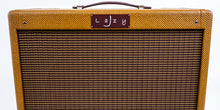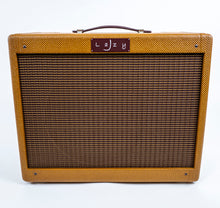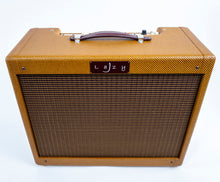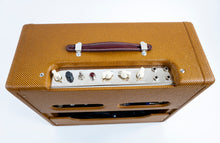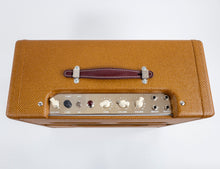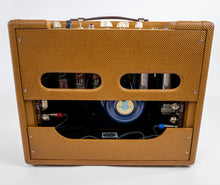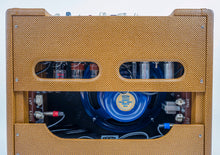
There are Tweeds and then there are TWEEDS and the Lazy J lineup without a doubt, represents simply the most incredible take on a vintage tweed ever produced. The tones, from the most pristine cleans through to the most harmonically beautiful and complex overdrive will take your breath away and keep you mesmerized. There is a good reason why Townshend, Beck, Clapton, Gilmour, Bonamassa, Nalle Colt of Vintage Trouble and so many other greats have chosen the Lazy J as their main stage and recording amps. Once you plug in and play you’ll understand. There are very few amps that can provide the responsiveness and touch sensitivity that the Lazy Js produce. Set the amp for the wildest screaming overdrive, dial your guitar’s volume down to 7 and you have a beautiful singing clean tone without even a hint of dirt.
The Lazy J amps possess the very essence of classic blues, and the soul of classic rock n roll. From the most beautiful punchy clean tones to raunchy tweed grit through to singing, soaring notes with infinite bloom and sustain, the Lazy J is the perfect desert island amp.
"I’m hooked, and that is why I had to bring Lazy J here to America for all to enjoy." - Cliff
Destroy All Guitars is the exclusive dealer for Lazy J in North America.
The following is paraphrased from a 2018 review from The Guitar Magazine:
Many discerning pro and amateur players consider Jesse Hoff's amplifiers to be among the finest on the planet and the Jazy J J10LC could easily be the best Lazy J yet.
A while ago, a Lazy J customer inquired about ordering a custom-built, low-power amp based on a tweed Princeton. However, UK-based American amp guru and Lazy J mainman Jesse Hoff has never been a fan of single-ended circuits, so instead he developed a push-pull amplifier combining the preamp of his much-loved J20 with a 10-watt output stage. The result is this new addition to the Lazy J range, the J10LC.
VAC power scaling comes as standard, while Lazy J's optional extras include footswitchable spring reverb and tremolo modules.
Most narrow-panel tweed-derived circuits, the J10 included, are nominally two-channel amps. However, the 'normal' channel generally sounds not-so-normal. Consequently, it tends to get overlooked by most players. But in the case of the J10LC some rather cool tones are available. The normal channel of the J10LC IS very dark. Yet, with bridge P-90s and Filter'Trons, you get a fine and fat midrange honk that's fun for revved up jump blues or for Billy Gibbons style background textures.
The brilliant channel is very different, and expands the versatility of the normal channel. Although low-volume overdrive may have revived interest in 50s tweeds back in the 1970s, their clean tones are just as good. The J10 stays fairly clean with Strat single coils up to around four, and the tone sparkles, chimes and breathes. Add some reverb and it's so pretty and dynamic, you'll get lost in Steve Cropper and Hendrix for quite some time.
Despite the impressive clean headroom, the J10 certainly isn't short on gain, even with a 12AY7 for V1. It comes on gradually, and as you get to grips with the way that the volume and tone interact, you'll find loads of tonal shades. Best of all, the J10 does that classic 5E3 trick where you set the tone and brilliant volume almost all the way up, and turn the normal volume to the point just before the output level begins to drop. This causes the J10 to produce a ferociously splatty Neil Young pseudo-fuzz, and your guitar volume will begin to act more like a gain control. As you roll it back, the J10 gets progressively cleaner with relatively little drop in level.
Although rated at 10 watts, the J10 is a loud little critter and for home playing; the power scaling feature makes sense. Some folks have mixed feelings about power scaling because it doesn't always produce the best results, but Lazy J's Variable Attenuation Control is hard to fault. The tonal character remains remarkably consistent, with the attenuated sound retaining brightness and clarity. It's also devoid of harshness or grit. You may experience a lightness in bass response at low volumes – with and without power scaling activated – but that's where the bass switch comes in handy.
Like the mid-boost switch, its effect is noticeable without being over the top. Rather than dramatically altering the J10’s voicing, the effect is more like switching from modern to old-style octal preamp valves. Depending on the volume setting, a moderate increase in overdrive accompanies a thickening of the mids. The drive also smooths out and touch response feels slightly more compressed.
In a boutique amp market that's saturated with tweed clones, Jesse Hoff stands out because he has always sought to add his own twist to the classic recipe. Even without all the optional features, the J10 would be an exciting amp, but with the extras onboard, it's ideal for practicing at home, low volume jamming and easy recording. It's the most enjoyable Lazy J amplifier since the J20. Impressive stuff.
Unlike the J20, 6V6 power valves are the only option in the J10LC, but you can push the input harder with a 12AX7 preamp tube rather than the stock 12AY7, and a bit more clean headroom and low-end tightness accompanies a 5Y3 to GZ34 rectifier swap.
Lazy J J10LC
The Lazy J J10LC is built on a J20 chassis and housed in a J20 cabinet. It has a 12" speaker. Reverb and trem are optional, like on all the other amps, and the VAC attenuator is on-board, Like on the J20. The amp has 4 inputs, Bright Hi and Lo and Normal Hi & Lo like on a J20...and a single tone control which has a push/pull for mid boost. The amp uses two 12AX7s, a 5Y3 rectifier and a pair of 6V6s in the output section.
Variable Attenuation Control (VAC)
This circuit allows the user to reduce the output of the amp in an even sweep from full power down to less than 5 watts. However, this is not a master volume. This circuit retains the amp's tone and response while reducing its output volume. In other words, you turn your amp up to get the tone you want… which might make it too loud for certain situations. Now you can turn the amp down with the VAC to exactly the level you need while retaining all the character and response of your sound.
ARTISTS ACTIVELY USING LAZY J AMPS (THE SHORT LIST):
Jeff Beck, Eric Clapton, Nalle Colt (Vintage Trouble), David Gilmour, Mark Knopfler, Pete Townshend, Joe Walsh, Steve Winwood.
ARTISTS ACTIVELY USING LAZY J AMPS (THE LONG LIST):
Richard Ashcroft, Jeff Beck, Sam Beer, Bleech, Joe Bonamassa, Doyle Bramhall 2 (Eric Clapton, Sheryl Crow, Arc Angels, David Gilmour, etc.), Dom Brown (Duran Duran), Dylan Burns (The Bodyrockers), Bernard Butler, Mike Campbell (Tom Petty and the Heartbreakers), Eric Clapton, Nalle Colt (Vintage Trouble), Alan Darby (Eric Clapton, Bonnie Raitt, Queen, Van Morrison, etc...), Gwyn Garfield Davies, Al Duncan, Lu Edmonds (Billy Bragg and the blokes, P.I.L., etc.), Olivier Elen (Gentlemen of Verona), Audley Freed, Noel Gallagher, David Gilmour, Dennis Greaves (Nine below zero), Mark Griffiths (The Shadows), Gary Hooker (Brad Paisley), Neil Ivison (The Misers), Jonas Jalhay (Rita Ora, Them is me, The Saturdays, I blame Coco, etc.), Simon Johnson, Gary Kemp, Mark Knopfler, The Kooks, Robbie McIntosh, The Magic Numbers, Ray Majors, Scott McKeon, John Parricceli, Adam Phillips, P.I.L., Luke Potashnick, Razorlight, Paul Sayer, Ivor Sims (Saint Jude), Dan Smith (The Noisettes), Whit Smith (The Hotclub of Cowtown), Jeremy Stacey, Paul Stacey, Dan Steinhardt, The Temperance Movement, Pete Townshend, Rafael Villafane (Royer Mics, Baby'O Music), Joe Walsh, Paul Weller, Steve Winwood.
- Power rating: 10 watts
- Valves: 1x 12AY7, 2x 6V6, 1x 5Y3
- Control panel: 4x input sockets, volume, volume, tone/mid boost, power, VAC
- Rear panel: 2x speaker outs, bass roll-off switch
- Speaker: 1×12" Celestion Blue
- Dimensions: 510mm x 410mm x 210mm
- Weight: 35lbs/15.9kg
- J10LC 1x12: $3,700.00
(Reverb unit, Trem unit, and footpedal to control Reverb and Trem are available by request)








